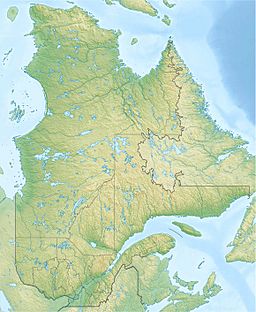Lake Minto facts for kids
Quick facts for kids Lake Minto |
|
|---|---|
 |
|
| Location | Baie-d'Hudson, Kativik, Quebec |
| Coordinates | 57°13′07″N 75°00′45″W / 57.21861°N 75.01250°W |
| Type | Oligotrophic |
| Primary inflows | Charpentier River and other rivers |
| Primary outflows | Leaf River |
| Basin countries | Canada |
| Max. length | 81 km (50 mi) |
| Max. width | 22 km (14 mi) |
| Surface area | 761 km2 (294 sq mi) |
| Surface elevation | 168 m (551 ft) |
Lake Minto is a large and beautiful lake located in northern Quebec, Canada. In the Inuit language, it is called Qasigialik, which means "where there are spotted seals." This lake covers a total area of about 761 square kilometers (294 square miles).
Contents
Discover Lake Minto
Lake Minto is considered one of the most beautiful lakes in northern Quebec. It is a great place to explore the natural beauty of Canada's wilderness.
Naming the Lake
The lake was named in 1898 by a Canadian explorer and geologist named Albert Peter Low. He named it after Gilbert Elliot-Murray-Kynynmound, 4th Earl of Minto. At that time, the Earl of Minto was the Governor General of Canada. A Governor General is the Queen or King's representative in a country like Canada.
Where is Lake Minto?
Lake Minto is located on the western part of the Ungava Peninsula in Nunavik, Quebec. It is only about 60 kilometers (37 miles) east of Hudson Bay. The lake sits in a valley surrounded by several rows of hills.
Even though it's close to Hudson Bay, the water from Lake Minto flows in a different direction. Its outlet, the Leaf River, flows north-east for about 265 kilometers (165 miles) all the way to Ungava Bay.
A Great Place for Canoeing
Because of its unique flow, Lake Minto is often used by canoeists. It is especially popular for those who want to cross the Ungava region from west to east. The lake and the Leaf River provide a long, scenic route for adventure.
What Kind of Lake Is It?
Lake Minto is an Oligotrophic lake. This means it has very clear water and low levels of nutrients. Lakes like this usually have deep, clean water and support specific types of fish and plants.
See also
 In Spanish: Lago Minto para niños
In Spanish: Lago Minto para niños


